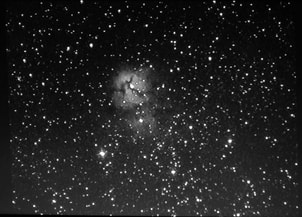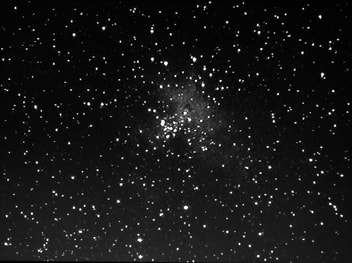EAA and Outreach : Using the GStar-Ex camera
|
The GStar-Ex video camera lent itself to easy group viewing and was therefore very suitable for public outreach purposes. An early attempt matched it with the Meade ETX 90EC. Latterly it was used with the Vixen R130sf.
An example of the camera's use with the ETX 90EC was this setup at a caravan park in Bonny Hills, NSW. The two images show the setup at work and the daytime context of the BBQ table used.
|
The combination of the Vixen R130sf 5 inch telescope and the aging GStar-Ex video camera turned out to be ideal for public outreach purposes. Mounted on the SkyWatcher EQ3-2 mount the whole setup was very light and was easily transported. An added benefit was that the setup's small size was not in the least intimidating and showed the public that one does not need large and expensive equipment to enjoy astronomy. The telescope's focuser had no difficulty in taking the camera's weight and held focus very well. The RA drive motor easily handled the camera's maximum x128 frame accumulation (equivalent to 2.5 seconds exposure time) without the need for any guiding. Provided that the mount was roughly polar aligned to start with, the camera's image output remained steady on the screen of the attached small 12 volt TV monitor. The images shown below were taken in one session by simply pointing a cheap digital camera at the TV screen. They are a fair representation of what the viewer actually saw on the screen.
|
For deep sky objects the setup worked best when configured to deliver the widest possible field of view so as to ensure the brightest possible image. The addition of a x0.5 focal reducer achieved a fov of more than 1 degree. And a Baader IR-Cut Moon and Skyglow filter certainly helped to improve contrast under suburban skies. The light gathered was more than sufficient to let the camera's digital zoom feature enlarge target objects on the TV screen.
|
Video astronomy has a number of benefits for public outreach purposes. The fact that more than one person can view at a time encourages group discussion of the object being viewed and, of course, there is no waiting time in queuing up to look through an eyepiece. The object is always in focus for all viewers without any need to adjust the focuser to suit each individual's eyesight. And because of the electronic wizardry in the video camera, the on-screen image is likely to be much brighter and therefore more easily seen than would be the case if the object was viewed through the eyepiece of even quite a larger telescope. Of course the on-screen view is quite grainy and there is no doubt that eyepiece viewing does deliver better quality images albeit that they may be dimmer. Although the GStar-Ex camera delivered satisfactory views of the brighter deep sky objects more modern video cameras that have longer effective exposure times are able to display much fainter objects and in colour too!.
|
But showing just black-and-white on-screen images was not such a drawback. Unless a very large telescope is used, the view in an eyepiece is also likely to be seen only in black-and-white.
|









